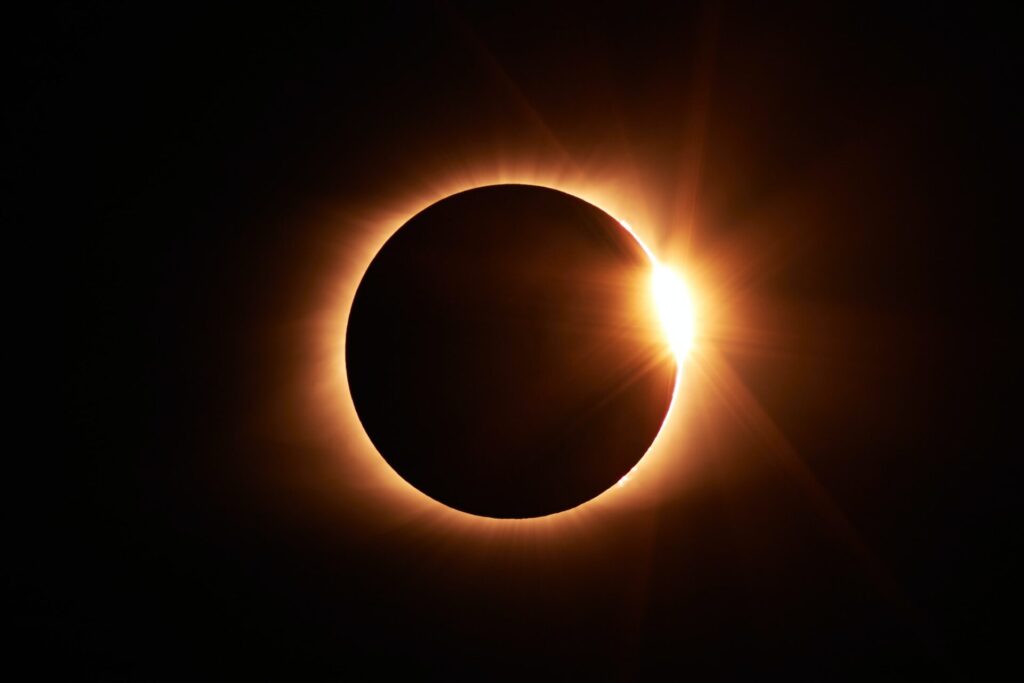A solar eclipse is an astronomical event that occurs when the Moon passes between the Sun and the Earth, casting a shadow on Earth that either fully or partially blocks the Sun’s light in some areas. Viewing of upcoming Solar eclipse is relatively rare event, but they can be observed from different parts of the world every few years.
Types Of Solar Eclipse
There are four types of solar eclipses:
- Total solar eclipse: This occurs when the Moon completely blocks the Sun, creating a shadow on Earth where it is completely dark for a few minutes.
- Partial solar eclipse: This occurs when the Moon only partially blocks the Sun, creating a shadow on Earth where the Sun appears to have a bite taken out of it.
- Annular solar eclipse: This occurs when the Moon passes in front of the Sun but does not completely block it, creating a “ring of fire” effect around the Moon.
- Hybrid solar eclipse: This is a rare type of eclipse that starts out as an annular eclipse but becomes a total eclipse for a short period of time before ending as an annular eclipse.
Solar eclipses can be safely viewed using special eclipse glasses or a solar filter. It is never safe to look directly at the Sun, even during a solar eclipse, as this can cause serious eye damage. Solar eclipses have fascinated people for centuries. They are a reminder of the interconnectedness of our solar system and the vastness of the universe.
Upcoming Solar Eclipse
On September 17-18, 2024, an annular solar eclipse will be visible from parts of the Americas. The eclipse will begin at sunrise in the Pacific Ocean and cross North America, Central America, and South America. The path of totality, where the Moon will completely block the Sun, will pass through parts of the United States, Mexico, Belize, Guatemala, Honduras, Nicaragua, Costa Rica, Panama, Colombia, Ecuador, Peru, Bolivia, Brazil, and Argentina.

To safely view the annular solar eclipse, you will need special eclipse glasses or a solar filter. It is never safe to look directly at the Sun, even during a solar eclipse, as this can cause serious eye damage. The upcoming annular solar eclipse is a great opportunity to witness a rare and awe-inspiring celestial event. If you are lucky enough to be in the path of totality, be sure to mark your calendars and prepare to experience this amazing phenomenon.
How To View Solar Eclipse Safely?
Here are some tips for safely viewing the annular solar eclipse:
- Purchase eclipse glasses or a solar filter from a reputable dealer.
- Make sure your eclipse glasses or solar filter are in good condition and meet international safety standards.
- Never look directly at the Sun without eclipse glasses or a solar filter, even during a solar eclipse.
- Supervise children at all times while they are viewing the solar eclipse.
- If you are using a telescope to view the solar eclipse, make sure to use a solar filter that is specifically designed for telescopes.
The annular solar eclipse of September 17-18, 2024, is a unique opportunity to experience the power and beauty of the cosmos. By following these safety tips, you can safely enjoy this amazing event.
Conclusion
Solar eclipses are amazing natural events that offer us a glimpse of the cosmos. They are a reminder of the interconnectedness of our solar system and the vastness of the universe. While solar eclipses are relatively rare, they are becoming more accessible to people all over the world.
FAQs
An annular solar eclipse occurs when the Moon passes in front of the Sun, but does not completely block it. This creates a “ring of fire” effect around the Moon.
The annular solar eclipse of September 17-18, 2024, will be visible from parts of the Americas. The eclipse will begin at sunrise in the Pacific Ocean and cross North America, Central America, and South America. The path of totality, where the Moon will completely block the Sun, will pass through parts of the United States, Mexico, Belize, Guatemala, Honduras, Nicaragua, Costa Rica, Panama, Colombia, Ecuador, Peru, Bolivia, Brazil, and Argentina.
The annular phase of the eclipse will last for several minutes, depending on your location. For example, in North America, the annular phase will last for up to 4 minutes and 33 seconds.
To safely view the annular solar eclipse, you will need special eclipse glasses or a solar filter. It is never safe to look directly at the Sun, even during a solar eclipse, as this can cause serious eye damage.
No, regular sunglasses are not safe for viewing the Sun, even during a solar eclipse. You must use special eclipse glasses or a solar filter that is specifically designed for safe solar viewing.
The exact time of the eclipse will vary depending on your location. For example, the eclipse will begin in Portland, Oregon around 9:13 AM PDT and end at 12:03 PM PDT. In Mexico City, Mexico, the eclipse will begin and will end around sunset off of Brazil.